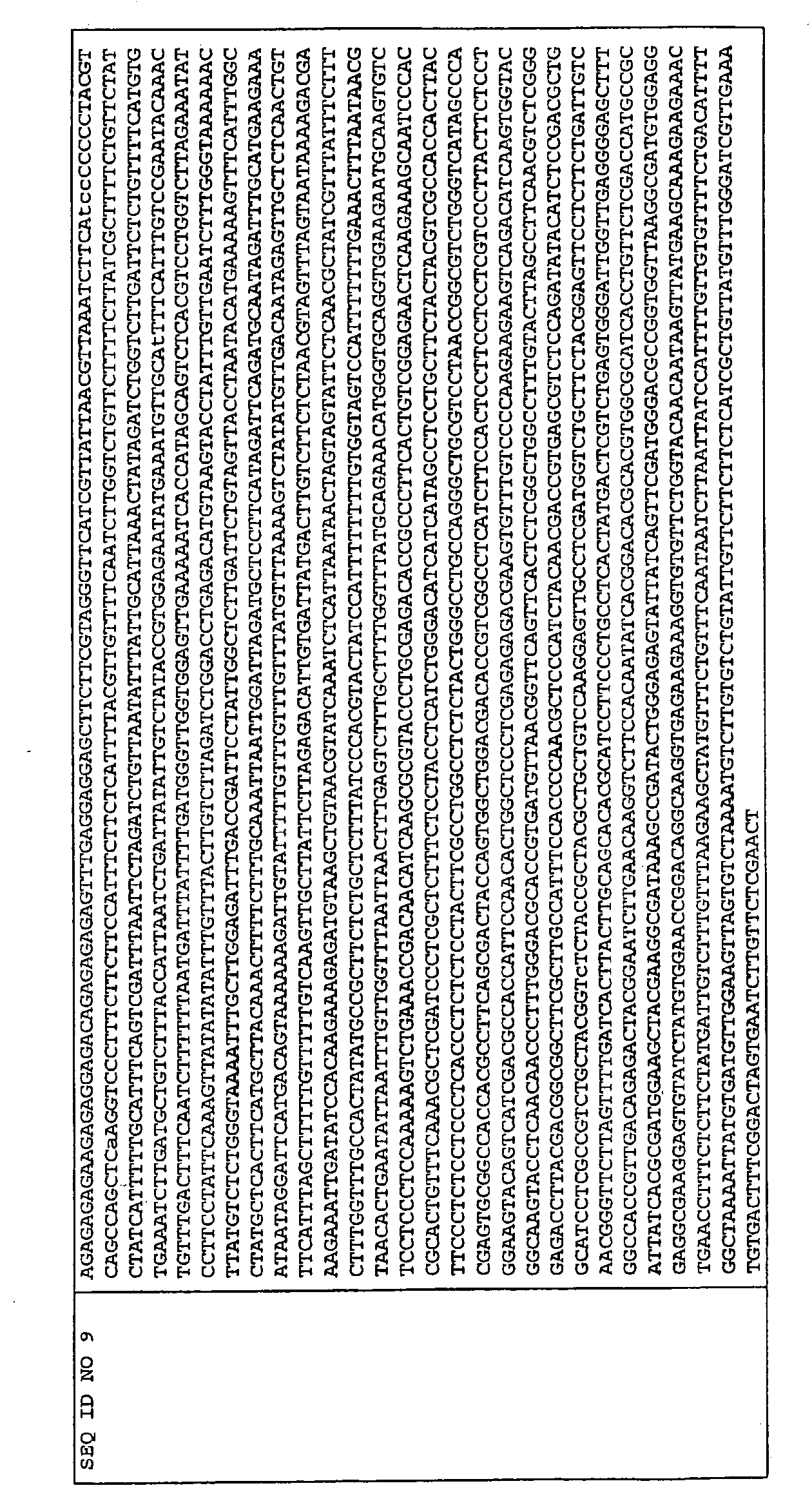Fad-2 mutants and high oleic plants
a high oleic plant, mutant technology, applied in the field of plants, seeds and products derived thereof, can solve the problems of poor agronomic value and/or bad root characteristics, and/or low yield capacity
- Summary
- Abstract
- Description
- Claims
- Application Information
AI Technical Summary
Benefits of technology
Problems solved by technology
Method used
Image
Examples
example 1
[0150]The seeds were grinded in a first solution consisting of methanol (800 ml), trimethyl-pentane (200 ml) and 5 g of Na OH. About 3 ml of solution was used for about 10 g of seeds (in other words about 10 to 50 seeds for 1 ml of solution).
[0151]Extraction was performed during 20 minutes and thereafter a second solution, consisting of trimethylamine (900 ml), and propanol, 2-(100 ml), was added at the same volume as the first solution.
[0152]The resulting solution was vortexed and allowed to rest until formation of an upper phase.
[0153]The upper phase was sampled and transferred into viols.
[0154]One microliter of same was injected in a gas chromatograph (Fisons from thermo-electron with a column DB3-30 meter with a diameter of 0.25 mm and a thickness of 25 micrometer). Running time was about 4 min.
[0155]The oleic acid content results are summarized in table 1.
TABLE 1VarietiesOleic acid content (wt. %)AppreciationCONTACT71.8-75.2HighCABRIOLET73.2-76.8High28DHS08680.3-83.1Very highMS...
example 2
[0157]Plant materials used for sequencing are:
[0158]mutant lines with higher oleic fatty acid content: CONTACT, CABRIOLET and 28DHS.086; and
[0159]wild type varieties with normal oleic acid content: Bristol, Capitol, Vivol, Capvert and Caiman.
[0160]All these lines were grown in a growth chamber and the cotyledons and stems were collected from 7-day-old plants.
[0161]The plant tissues were freeze-dried and used for DNA extraction.
[0162]DNA was isolated with Qiagen Plant DNA kits (Qiagen INC.-USA, Valencia Calif.).
[0163]PCR was performed with TaqGold protocol (AB Biosystem, Inc,).
[0164]Reaction mix includes 2.5 μl 10× buffer, 0.2 μl TaqGold, 0.2 μl dNTP (25 mM), 2 μl primers (5 uM) and 10 ul DNA template (2 ng / ul) and 10.1 ul H2O.
[0165]PCR cycles were as follows: 94° C. 5 min; 8 cycles of 94° C. 40 sec, 62° C. 40 sec, 72° C. 1 min, 94° C. 40 sec, 60° C. 40 sec, 72° C. 1 min, 94° C. 40 sec, 58° C. 40 sec, 72° C. 1 min, 94° C. 40 sec, 56° C. 40 sec, 72° C. 1 min; 3 cycles of 94° C. 40 sec...
example 3
[0172]Four Brassica napus delta-12 oleate desaturase (FAD2) gene sequences, 4684997, 46399190, 8705228 and 4092878, were downloaded from Genebank (NCBI). These sequences were used as queries to blast against Monsanto sequence database.
[0173]Using the “blastn” programs (NCBI), a number of high score hits were obtained. All the hit sequences were downloaded and reassembled with the SeqmanII program (DNASTAR Inc, Madison, Wis., USA).
[0174]Two distinct transcripts were identified and designated as Fad2-1 (SEQ ID NO 11) and Fad2-2 (SEQ ID NO 12). Fad2-1 and Fad2-2 share a high sequence homology, with 97% sequence identity.
[0175]To identify causative mutations associated with high oleic acid content in the mutant lines and their progenies, nested locus-specific primers were designed to cover the entire sequences.
[0176]The 3′ end of a primer was always located at a nucleotide that differentiated Fad2-1 from Fad2-2 except those located at 5′ and 3′ ends of the consensus sequences where ther...
PUM
| Property | Measurement | Unit |
|---|---|---|
| Temperature | aaaaa | aaaaa |
| Fraction | aaaaa | aaaaa |
| Fraction | aaaaa | aaaaa |
Abstract
Description
Claims
Application Information
 Login to View More
Login to View More - R&D
- Intellectual Property
- Life Sciences
- Materials
- Tech Scout
- Unparalleled Data Quality
- Higher Quality Content
- 60% Fewer Hallucinations
Browse by: Latest US Patents, China's latest patents, Technical Efficacy Thesaurus, Application Domain, Technology Topic, Popular Technical Reports.
© 2025 PatSnap. All rights reserved.Legal|Privacy policy|Modern Slavery Act Transparency Statement|Sitemap|About US| Contact US: help@patsnap.com



